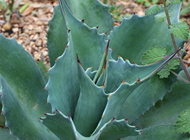 |
Garden journal |
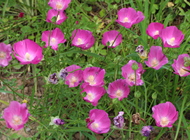 |
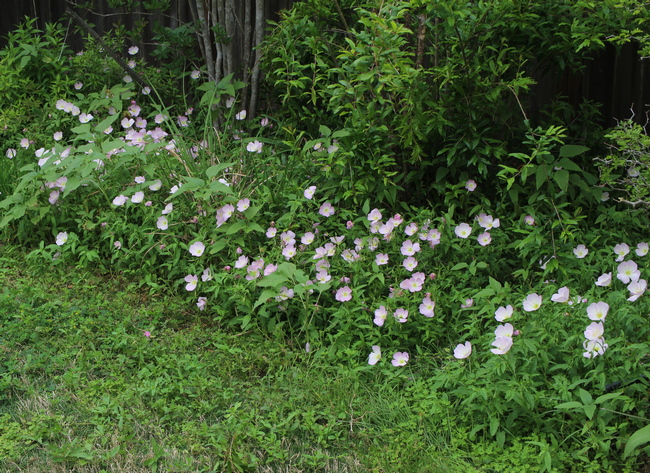
a sea of pink where I haven't found time to weed - even creeping into the lawn |
April 01, 2024. A profusion of evening primroses
Among the most recognizable of Texas wildflowers, competing along roadsides with bluebonnets and Indian paintbrushes for the title of most exuberant performer, pink evening primroses are certainly stellar in their eye-catching abundance, with large blowsy flowers carpeting whole swaths of meadowland. In my garden, I tolerate (or even welcome) many wildflowers and native plants, including those that come unbidden. I wish I could do the same for these primroses – because boy, do they make a statement! Alas, if I were to do so there wouldn't be much room for anything else in the garden – because boy, do they spread! I'm sure they seed around (why else produce such emphatic flowers?), but mostly they gain ground by extending their network of thin roots, popping up at ever greater distances from the original plants. I've found that once established they are nearly impossible to eradicate (I haven't succeeded yet in any area of the garden where they've taken hold); so the best I can do is vigilantly pull them up where I see them emerge, to keep them from smothering their neighbors. And I do secretly enjoy those flowers, even if I have no qualms about uprooting them en masse.Visitor comments
| U.w. plankeel | Apr 08, 2024 | Nice to see a new entry. Best wishes for a normal summer, not too Hot and with regular rain. |
Comment on this journal entry |
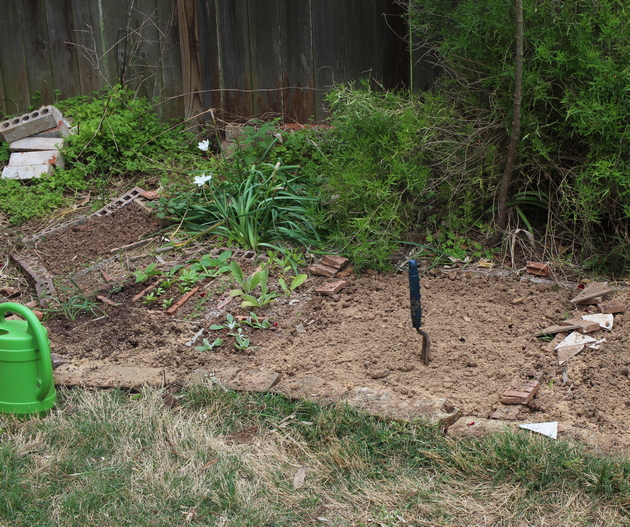
first seedlings installed, and ready for more! |
March 30, 2024. Spring rolls around again
Quick, I need to post before a full year goes by between my ramblings! Alas, the summer of 2023 was no better (worse, in fact) than 2022: unrelentingly hot and dry, sapping all my desire to engage productively with my ornamental garden (I kept the community farm plot going, to have at least a few okra to show for my efforts). I didn't even collect any seed from my garden last year, so that I had fewer varieties to start indoors over winter – but by the time December rolled around at least the memories of drought despair were starting to fade, and I did pursue my usual seed-starting activities with left-over seeds, augmented in late winter with shipments from the NARGS seed exchange. Which meant that recently, I needed to clear out room in my seedling nursery area to accept the new arrivals, some of which are starting to outgrow their seed pots. The first order of business is always to move any overwintering plants into permanent positions in the garden, a task that can take quite a bit of time. Not so this year: very few of last year's seedlings had survived. I suspect that most of them were done in by the summer drought, but we had a significant freeze in January as well, which may have killed off a few tender ones. In any case, the majority of the survivors were various rain lilies, which have proven amazingly resilient to anything Texas has thrown at me over the past seven years – and which are easy to tuck into various spots that can use an occasional color pop. A few days ago, all survivors had found new homes. Since I can't seem to keep my agave seedlings alive, I decided to further elevate one of my nursery beds by heavily amending it with sand, hoping to provide the well-drained conditions they require (although I can't be sure it's winter wet that's been killing them – those tiny seedlings are so hard to keep track of through their first year of life). Yesterday and today, the first batches of seedlings found their home there, and of course I'm optimistic that this year the weather will be friendlier, and I'll be more diligent in providing the conditions these young plants need to survive. Wish me luck!
Comment on this journal entry |
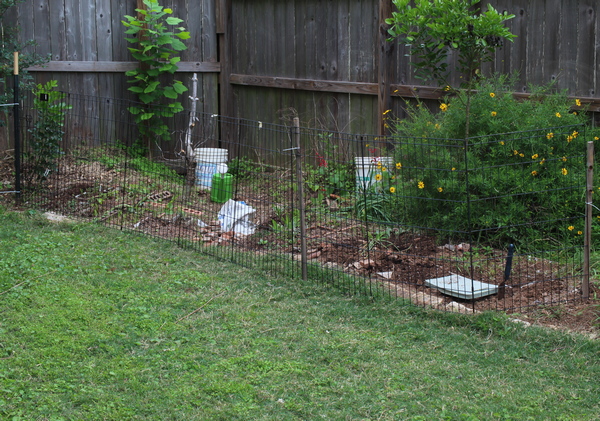
anti-dog defensive measures |
April 10, 2023. Getting caught up
Let's fast-forward from my last post, more than 10 months ago, to now, shall we? When I wrote in late May, I had been in a very active gardening mode all spring, busying myself with seedlings as always, engaging in a bit of a plant sale for the first time in years, and connecting with local gardeners in a plant swap. It had been a good spring, following a winter with relatively mild freezes and reasonable rainfall as the weather got warmer. But then, in June, the rain just stopped coming. And stayed away for nearly three months, even as the summer heat reached boiling level – it was probably not hotter than normal Texas summers, but with the lack of rain it sure felt that way. Early on in the drought I faithfully went around watering all the new seedlings and recent transplants, but even so many of them died – and after a while I just gave up, since going outside to see all the parched plants was no fun at all. Needless to say, my final yield from all the seedlings I started in winter of 2022 was quite poor. Eventually, some rain returned in fall (although it stayed decidedly on the dry side), and I started to take inventory of what had survived the drought – but then in mid-December, we were hit by a deep freeze that lasted the better part of a week. In most ways, it was slightly milder than winter storm Uri two years earlier, but it seemed to hit the plants at least as hard – in fact, some that had managed to survive Uri haven't made a second return, perhaps because the drought had not been kind to them. So by mid-winter, the backyard was sadly depleted of plants. My indoor seed-starting was going on as usual, but there wasn't much reason to venture outside until recently. Now, finally, the plants whose roots survived are making their comeback from the base, and everything is greening up. Not necessarily the things I want to be greening up, though: it seems like my season of neglect last year was an excellent opportunity for several noxious weeds to dramatically extend their range, so tackling their infestations has been a big job in the past few weeks. But I'm getting there.
One last anti-garden force I hadn't yet mentioned: our new puppy Birdie, a hyper-active black mutt with a love of both digging and running (with no regard whatsoever for the plants that might be in her way). Our backyard is a collection of holes, and many of last year's surviving seedlings that I had transplanted to various borders found that they were no match for Birdie's claws (which are excellent digging devices). When she also took an interest in the new seedlings that are now finding their way into my nursery areas, it was obvious that some protective measures were in order. So I rigged up some panels that used to be part of a puppy corral to some fenceposts to limit easy access to my lovingly planted seedlings. It's too early to say if that's going to be fully effective – but for the sake of Birdie's continued well-being, I sure hope so!
Comment on this journal entry |
May 27, 2022. Rock garden zone update
The extended area in front of the rock garden that I worked on last year, and wrote about in a few journal posts, has progressed nicely in its first spring. Most of its plants survived the winter (which saw some moderate freezes), and some seem decidedly happier than they were in their previous homes. For example, the Bergeranthus vespertinus bloomed for the first time in its new spot, as did two different manfredas. The whale's tongue agaves have room to strut their stuff, and various rain llies are adding color, as does a nice stand of snake herb. My choice to stick with mostly plants whose foliage stays lower (although some have flower spikes that reach up higher) has worked out nicely so far, allowing us to take in most of the plants just by walking along the front edge of the area. Of course, then I often spot something I'd like to view up close, and dive further in along the stepping stones. The rock garden proper, visible in the top left of the photo, has taken a bit of a back seat, as the two large nodding Texas yuccas have grown so big as to claim much of its area – but it still houses a variety of drought-tolerant plants that require good drainage.
Overall I'm quite pleased with the rock garden zone – which means, of course, that I'm considering enlarging it one of these days. But maybe I'll wait till the Texas heat subsides – it's already summer-time as far as temperatures go...
Comment on this journal entry |
May 21, 2022. The battle of St Augustine and Bermuda
In our neighborhood, the HOA decides a lot of things for us. One of those things is the type of grass in our front yard: it must be Bermuda. While I have my quibbles with Bermudagrass (it is one of the worst weeds of my garden borders, for one), I have accepted this edict as established law, and at least appreciate its low water requirements. As it turns out, the HOA does not regulate the grass in the back yard (as long as it doesn't grow taller than our fences, I guess), and my one-time neighbor decided St. Augustine would be good to establish in some areas of his plot. A few years have passed, new neighbors moved in, and St. Augustine has steadily extended its reach. It tries to invade my backyard from under the fence, but perennial borders line the fence the whole way, so it's not too difficult to spot and remove the coarse St. Augustine runners. But the front yard is a different story: St. Augustine has crept underneath the neighbors' fence and pretty much taken over the lawn in that area – and nothing separated their front lawn from mine, so I found myself waging a losing battle against marauding runners; I know it would be only a matter of time before the HOA would insist on a complete resodding of the front lawn if it goes to mostly St.Augustine. This spring it was clear I needed to take decisive action, so I installed a line of bricks separating our lawns. St. Augustine, as far as I can tell, spreads only by stout above-ground stolons, which eventually burrow into the soil and sprout roots along their length. So I did not need a root barrier – just a way of spotting the runners before they have time to get too cozy with my lawn. After laying the bricks, I spent hours manually removing all of the St. Augustine that had already established (see photo at top right to appreciate to what extent the coarser grass was winning the battle), accumulating quite a pile of stoloniferous debris. I expect to spend more time clearing up the bits I missed through the rest of this year. In the aftermath, the contrast between the lawns is stark. The left side with St. Augustine looks lush and deep green, while the right side, where Bermuda had been under attack for some time and the invader removal process destroyed much of what was left, is frankly a mess. But I hope for a revival in the next few months, and will maintain vigilance from here on out, using my concrete fortifications as line that shall not be crossed.
Comment on this journal entry |
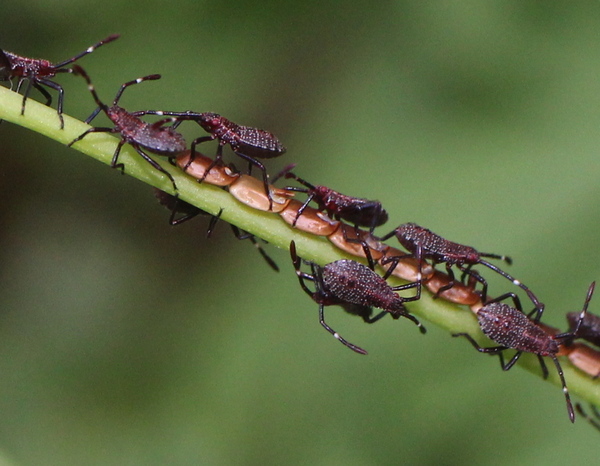
Reminds me of an Escher drawing of ants marching in different directions |
May 11, 2022. A procession of buglings
As temperatures are getting steamy once again, I was taking a break from actual gardening and roaming around with my camera, when I spotted a bunch of katydid nymphs on a columbine plant. Then, when I hunched down to take their picture, I noticed another interesting procession of insects on a single stem of the same columbine. They were too small to make out what they were, but I snapped a few quick photos before returning to the katydids. When I looked at the results later, I was amazed to see that I had captured a pretty nice picture of early-stage bug nymphs (identity unknown), who appear to be marching back and forth across another set of structures (eggs? scale insects?). When I returned later, I could no longer find the insects or that stem, but I'm glad I got their mugshots.
Comment on this journal entry |
April 17, 2022. The eternal chase
In the earlier days of my gardening hobby, most gift-giving occasions brought new pieces of garden art to be displayed around the burgeoning borders. Only a few of them made the trip from Pennsylvania to Houston (the smaller pieces tend to have a limited life span in the garden anyway), and since then there have been a few new items added – most notably, a bicycle spinner and a big green man – but the pace has definitely slowed down. So it was time for something new, and the spirit of vacation (a spring-break trip Amy and I made to Fredericksburg) was just the incentive to come back with something new for the garden. We found this balancing act at Wildseed Farm (where alas, the wildflowers were not yet in bloom at the time) and decided it struck the right balance between whimsy and substance (in size, anyway) – so it now lives in our garden. We might consider it a monument to our aging cat Bear, who calls the back yard his home, and despite his various ailments can be spry when the mood strikes – like last week, when he brought us a dead rat, no doubt captured near our compost pile where the pickings are good for rat families. We hope that in the metal version, the feline never catches the rodent.
Comment on this journal entry |
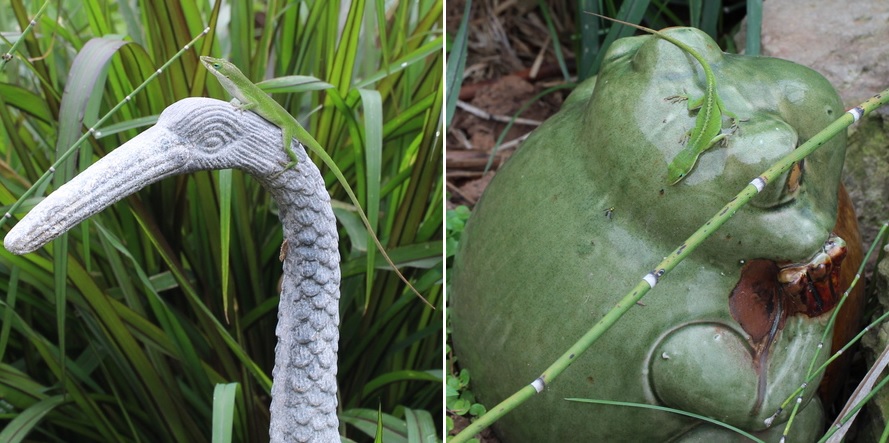
Do you like my party hat? |
April 16, 2022. You too can wear an anole hat
Our most common resident reptiles, the Carolina anoles, are once again out in full force. They bring a smile to my face whenever I see them in the garden – sometimes scurrying, but usually just lazing about, often in unexpected places. So it was this morning: I was sitting at the breakfast table, glancing outside, when I spotted something sprouting from the head of the metal crane that keeps watch over our pond. Venturing outside to explore, I soon found out it was a boy anole, puffing his throat periodically. A little while later, another one was using a garden ornament's head as a perch: this one had selected my rotund frog as a place to sun itself. Welcome, little lizards!
Comment on this journal entry |
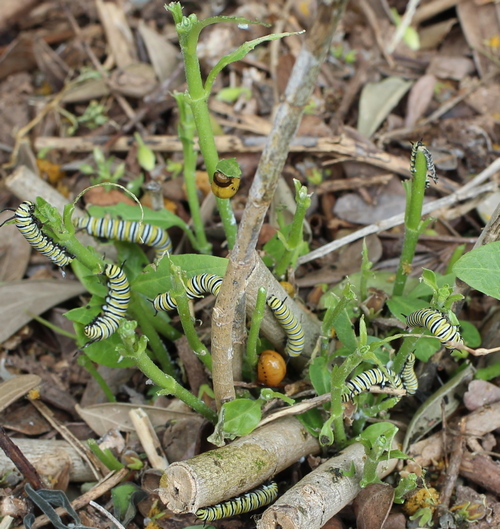
the banquet hall is running low on food |
April 10, 2022. Too many monarch babies
Oh my! It seems that this tropical milkweed, which was just starting its growth spurt as warm weather arrived, couldn't outrun the onslaught of monarch younglings. Their mama may have been over-eager in her desire to quickly find homes for her offspring, but I fear for their survival – there isn't much left to eat!Visitor comments
| Misti | Apr 26, 2022 | I currently have too many pipevine caterpillars! Luckily they are all starting to pupate and my pipevine can recover! |
Comment on this journal entry |
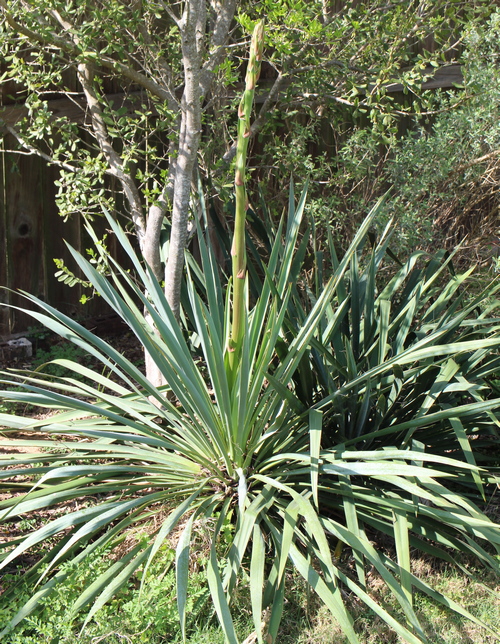
Yucca cernua preparing for a flower show |
April 09, 2022. Changing of the yucca guard
It's fun to observe and learn the habits and cycles of perennial plants – while many of them reliably bloom every year once they reach their second year (or even in their first year), others follow more particular patterns. I was reminded of this by our nodding Texas soapwort plants this year. Four years ago, I started some of these yuccas from seed, and by the next spring, I had four year-old plants to place in the garden. I put two of them in our original Houston rock garden, and two in a border at the base of a Texas persimmon. The ones in the rock garden grew faster, but both sets proved strong and hardy, growing well beyond the space I envisioned for them (but that's typical for me). Last year, one of the rock garden set bloomed for the first time, treating us to a nice display of its nodding white flowers. So I figured we'd see the whole lot of them burst into flower this year, but no such luck: this time, one of the set by the persimmon decided to send up a flower stalk (it has a way to go before actually blooming), while the others seem content to sit out the year. So now I'm tempted to number my plants, and see how they sequence their flower shows. Is it the one that was happiest the previous year that decides to bloom? Or do they follow a predictable pattern of blooming once every two or three years? Check back here in years to come – I plan to document it for myself, and for you!Visitor comments
| Rob | May 04, 2022 | PS: In the end, both of the plants in the rock garden sent up spikes as well, but they waited until late April/early May to do so. I love garden surprises! |
Comment on this journal entry |
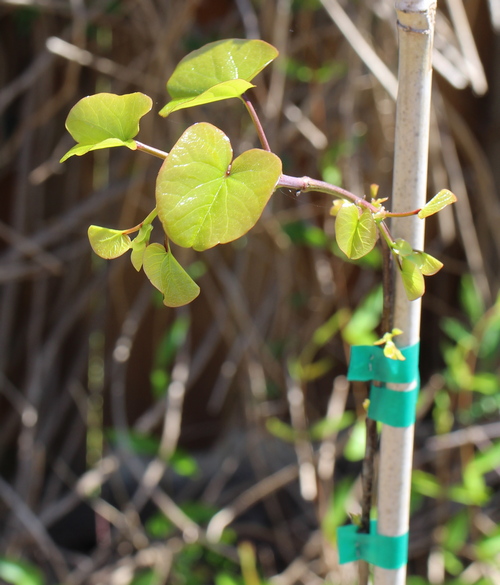
It lives! |
April 03, 2022. Buying a stick
Apologies for the long hiatus – for a while, there wasn't much new to write about, and for the past few weeks, I've been busy keeping up with the springtime acceleration in the garden. I could spend a full week hacking away at the rampant weeds and still not be done! But I've made some progress, and also decided to try selling a few plants again. Not one big plant sale, as I did in Pennsylvania, but a few plants here and there on "open afternoons" on the weekends. I haven't established a reputation or a clientele yet, so it's been slow-going, but we'll see. I do enjoy potting up plants to share with fellow gardeners, and hope that most of them will make their way into suitable homes in the next few weeks. Amid all that activity, Amy and I did find some time one Saturday to go to a local nursery that prides itself on carrying native plants. One of the things we were looking for was a redbud, preferably the Texas subspecies, to replace one of the citrus trees that had died behind our pond in last year's freeze. Alongside several regular redbuds, we found one spindly texensis representative, with two of last year's leaves still attached. By the time we had hauled it to the checkout counter, those leaves had fallen off, leaving us with a pencil-thin stick supposedly worth fifty dollars. Well, we took the plunge, and watched anxiously for signs of life in the following weeks. And sure enough, in recent days, promising buds started to develop, which soon produced shiny delicate new leaves. We hope our tree will be happy in its new home and grow quickly: we're looking forward to the flower show!
Comment on this journal entry |
Journal entries for previous seasons
2004
2005
2006
2007
2008
2009
2010
2011
2012
2013
2014
2015
2016
2017
2018
2019
2020
2021
Last modified:
April 01, 2024
Contact me
|